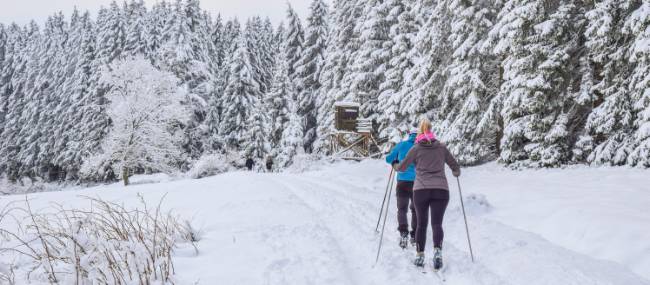
There are numerous benefits of winter sports, and look at this view
Blog home / A First Timer’s Guide to Cross-Country Skiing
by Robin Esrock
When I immigrated to Canada in my twenties, I took up snowboarding because that’s what the cool kids did. Learning to board wasn’t easy; decades later, I wish I’d channelled all my time and energy into skiing. It’s so much easier on the body (and middle-aged dads are not cool kids anymore). As for cross-country skiing, I thought I’d need at least some experience on skis before attempting an 11-kilometre trail into the thick winter snow of Banff National Park. Instead, I discovered why Nordic skiing is so alluring and popular, even if you’ve never put on skis before. Whether you’re in the mountains or on a local trail, here’s a first-timer’s guide to get you going.
There are two cross-country techniques, known as Classic Skiing and Skate Skiing. If you’re a beginner, you’ll start with the Classic style because it’s just like walking and a much better form of exercise. Kick into your thin skis, and start shuffling along, carving out two parallel tracks in the snow (or following the tracks laid before you). Push your arms out as if on an elliptical machine in the gym, pushing down in the middle of your ski. This creates a rhythm that quickly gets you into a flow on flat terrain. Once you’re going, you’ll feel a glide sensation, and you can lengthen your stride to cover more distance. Now you’re off, covering a good distance in the pristine winter wilderness. Most beginner runs are quite flat, taking you across frozen lakes or along popular trails. Once I felt comfortable on flat terrain, I approached my first hill.

The trick now is to shorten your stride, turning your skis outward into a V shape and pushing off against each leg, transferring weight from one foot to the other while keeping your legs bent. It reminded me of ice skating, which I also can’t do very well, and it took a few minutes to get my balance sound enough to feel comfortable on the incline. Depending on the hill, you might reach the top in a few seconds, or it could be a leg burner requiring a few breaks to catch your breath. Either way, what goes up, must come down.
Skiing downhill on Nordic skis applies the same principles of downhill skiing, which would be great if I knew how to downhill ski. No problem: it’s the same ‘French fries and pizza’ technique taught to kids on bunny slopes everywhere: parallel skis go faster, and making a wedge to push against the snow slows you down. Of course, you don’t have the same ankle support as with regular skis, and the truth is I wiped out a half dozen times on my first big downhill. The snow was soft, and my boots clicked out easily, reducing the chance of injury. Try and fall on your side and avoid using the polls to hold you up. If you’re on a trail with people behind you, shuffle off it so nobody on the tracks skis into you. By the third hill, I was confidently making it to the bottom without falling to begin the shuffle again. By the third kilometre, I was eating up the metres with a big grin on my face.

The Skate style of cross-country skiing is a little more complicated, with a hockey-skate style propelling you along in a rhythm that cranks the speed. If you’re on a popular route, anyone blitzing past you will probably be ‘skating’ on smaller skis, and this is the technique you’ll see in the Winter Olympics. For the rest of us, what’s the hurry?
Gear wise, guides will fit you with the right ski length and skins. This is a fabric that slips over your skis and helps with grip on the snow. Beginner skis typically have scales, while experienced skiers use wax to increase speed and control. Poles work much the same as hiking poles, pulling you along with additional support. Cross-country is an endurance sport, heating you up and cooling you down with the ups and downs of the terrain. Wear moisture-wicking layers, make sure you can wiggle your toes in the boots, and if you’re worried about blisters, wear one thin and one thick pair of socks. Stop for water breaks, and remember to stop and smell the pine forests.

There are cross-country skiing opportunities for beginners and advanced skiers on GCT’s Classic Canadian Winter Adventure in the wilderness of Algonquin Park, offering abundant lakes and exquisite terrain. Combined with snowshoeing and dogsledding, it makes for a complete outdoor winter adventure. Further west, guides will help you cross-country ski along the Johnston Canyon in Banff National Park with GCT’s Rockies Winter Highlights package. No experience is necessary.
Don’t be intimidated. Cross-country skiing immerses you in Canada’s great outdoor winter destinations. With a basic level of fitness and an attitude toward adventure, the sport can be enjoyed by all ages. Once you start, you’ll understand why cross-country skiing is an exercise with benefits and a pastime that millions around the world look forward to each winter.
Robin Esrock is a renowned travel journalist and the bestselling author of The Great Canadian Bucket List.